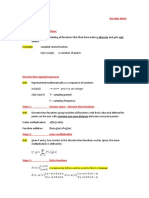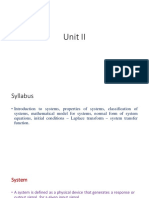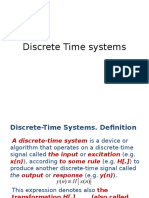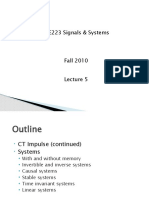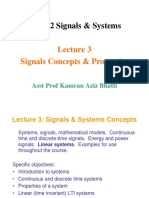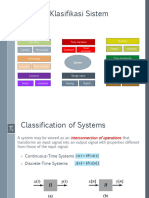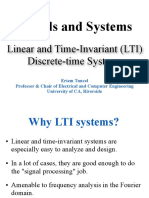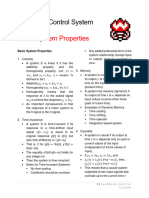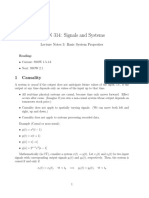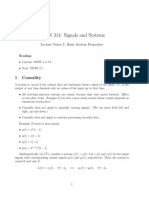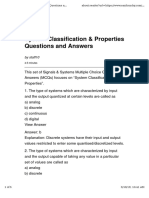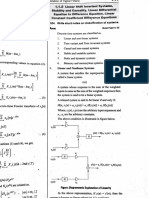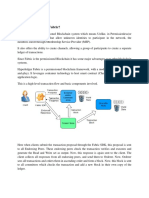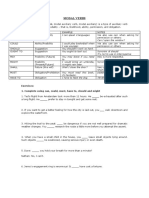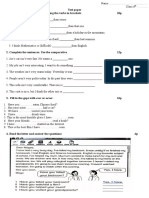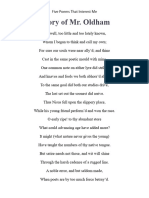Signals and Systems
Arun B Aloshious
”Every sentence I utter must be understood not as an affirmation, but as a
question”. - Earlier by Neils Bohr
1/3
�System as interconnection of basic operations
Discrete time system
Continuous time system ▶ y [n] = x[n − 3]
▶ y (t) = x(t) ▶ y [n] = 0.5x[n] + 0.25x[n − 1] + 0.25x[n − 2]
▶ y (t) = t ▶ y [n] = 0.25y [n − 1] + 0.75x[n]
▶ y (t) = x 2 (t) ▶ y [n] = e x[n]
▶ y (t) = 5 + x(t) ▶ y [n] = cos(2πx[n])
2 x(t)
∞ ∞
▶ y (t) = 3 dx(t)
dt + 2 d dt ▶ y [n] =
P
ak x[n − k] +
P
bk y [n − k]
k=−∞ k=−∞,k̸=0
∞ k y (t) ∞ k x(t)
▶ αk d βk d
P P
dt = dt
k=0 k=0
2/3
�Properties of a system
Properties: y (t) = H(x(t)) or y [n] = H(x[n])
1. Linearity Linearity = Homogeneity + Superposition
2. Time/Shift
invariant
3. Memory- .
less
4. Causality
x(t) (or x[n]) H(.) y (t)( or y [n])
5. Stability
6. Invertability
3/3
�Properties of a system
Properties: y (t) = H(x(t)) or y [n] = H(x[n])
1. Linearity Linearity = Homogeneity + Superposition
2. Time/Shift
invariant
3. Memory- .
less
4. Causality
x1 (t) H(.) y1 (t)
5. Stability
6. Invertability
3/3
�Properties of a system
Properties: y (t) = H(x(t)) or y [n] = H(x[n])
1. Linearity Linearity = Homogeneity + Superposition
2. Time/Shift
invariant
3. Memory- .
less
4. Causality
x2 (t) H(.) y2 (t)
5. Stability
6. Invertability
3/3
�Properties of a system
Properties: y (t) = H(x(t)) or y [n] = H(x[n])
1. Linearity Linearity = Homogeneity + Superposition
2. Time/Shift For CT systems: H(αx1 (t) + βx2 (t)) = αH(x1 (t)) + βH(x2 (t))
invariant For DT systems: H(αx1 [n] + βx2 [n]) = αH(x1 [n]) + βH(x2 [n])
. ∀α, β ∈ C for complex signals (or R for real signals)
3. Memory-
less
4. Causality
αx1 (t) + βx2 (t) H(.) αy1 (t) + βy2 (t)
5. Stability
6. Invertability
3/3
�Properties of a system
Properties:
1. Linearity Examples:
2. Time/Shift ▶ y (t) = x(t) + 5
invariant ▶ y (t) = dx(t)
dt
3. Memory- . ▶ y (t) = x 2 (t)
less ▶ y [n] = x[n] − 0.5y [n − 1]
4. Causality ▶ y [n] = e x[n]
5. Stability ▶ y [n] = nx[n]
6. Invertability
3/3
�Properties of a system
Properties:
1. Linearity Examples:
2. Time/Shift ▶ y (t) = x(t) + 5 Non-Linear
invariant ▶ y (t) = dx(t)
dt Linear
3. Memory- . ▶ y (t) = x 2 (t) Non-Linear
less ▶ y [n] = x[n] − 0.5y [n − 1] Linear
4. Causality ▶ y [n] = e x[n] Non-Linear
5. Stability ▶ y [n] = nx[n] Linear
6. Invertability
3/3
�Properties of a system
Properties:
1. Linearity If H(x(t)) = y (t) or H(x[n]) = y [n]
2. Time/Shift
invariant
3. Memory- .
less
4. Causality x(t) H(.) y (t))
5. Stability
6. Invertability
3/3
�Properties of a system
Properties:
1. Linearity
For CT systems/Time invariant: H(x(t − t0 )) = y (t − t0 ) ∀t0 ∈ R
2. Time/Shift For DT systems/Shift invariant: H(αx[n − n0 ] = y [n − n0 ] ∀n0 ∈ Z
invariant
3. Memory- .
less
x(t − t0 ) H(.) y (t − t0 )
4. Causality
5. Stability
6. Invertability
3/3
�Properties of a system
Properties:
1. Linearity Examples
2. Time/Shift ▶ y (t) = x(t) + 5
invariant ▶ y (t) = dx(t)
dt
3. Memory- . ▶ y (t) = tx(t)
less ▶ y [n] = (−1)n x[n]
4. Causality ▶ y [n] = 0.4x[n] + 0.2x[n − 1]
5. Stability ▶ y [n] = 0.2x[n] − 0.8y [n − 1]
6. Invertability
3/3
�Properties of a system
Properties:
1. Linearity Examples
2. Time/Shift ▶ y (t) = x(t) + 5 Time invariant
invariant ▶ y (t) = dx(t)
dt Time invariant
3. Memory- . ▶ y (t) = tx(t) Time variant
less ▶ y [n] = (−1)n x[n] Shift variant
4. Causality ▶ y [n] = 0.4x[n] + 0.2x[n − 1] Shift invariant
5. Stability ▶ y [n] = 0.2x[n] − 0.8y [n − 1] Shift invariant
6. Invertability
3/3
�Properties of a system
Output depends only on the present input. y (t0 ) = f (x(t0 )) or
Properties: y [n0 ] = f (x[n0 ]).
1. Linearity
2. Time/Shift x(t) H(.) y (t)
invariant
3. Memory- .
Examples:
less
▶ y (t) = x 2 (t)
4. Causality
▶ y (t) = x(|t|)
5. Stability
▶ y [n] = (n − 1)x[n]
6. Invertability
▶ y [n] = x[2n ]
3/3
�Properties of a system
Output depends only on the present input. y (t0 ) = f (x(t0 )) or
Properties: y [n0 ] = f (x[n0 ]).
1. Linearity
2. Time/Shift x(t) H(.) y (t)
invariant
3. Memory- .
Examples:
less
▶ y (t) = x 2 (t) Memoryless
4. Causality
▶ y (t) = x(|t|) Not memoryless
5. Stability
▶ y [n] = (n − 1)x[n] Memoryless
6. Invertability
▶ y [n] = x[2n ] Not memoryless
3/3
�Properties of a system
Output depends only on the present and past input.
Examples:
Properties:
▶ y (t) = x 2 (t)
1. Linearity dx(t)
▶ y (t) = dt
2. Time/Shift
R∞
invariant ▶ y (t) = x(τ )dτ
. t
3. Memory-
▶ y (t) = x(t/2)
less
▶ y [n] = (n − 1)x[n]( n + 1)x[n − 1]
4. Causality
▶ y [n] = x[2n ]
5. Stability
6. Invertability
3/3
�Properties of a system
Output depends only on the present and past input.
Examples:
Properties:
▶ y (t) = x 2 (t) Causal
1. Linearity dx(t)
▶ y (t) = dt Causal
2. Time/Shift
R∞
invariant ▶ y (t) = x(τ )dτ Non - Causal
. t
3. Memory-
▶ y (t) = x(t/2) Non-Causal
less
▶ y [n] = (n − 1)x[n]( n + 1)x[n − 1] Causal
4. Causality
▶ y [n] = x[2n ] Not Causal
5. Stability
6. Invertability Note: A continuous time system y (t) = H(x(t)) is a causal system
if and only if y (t) = 0 for all t < 0 when x(t) = δ(t).
A discrete time system y [n] = H(x[n]) is a causal system if and only
if y [n] = 0 for all n < 0 when x[n] = δ[n].
3/3
�Properties of a system
A system y (t) = H(x(t)) is said to be a Bounded Input Bounded
Output (BIBO) stable if for all bounded signal x(t), y (t) is
bounded.
Properties:
1. Linearity
2. Time/Shift
invariant
3. Memory- .
less
4. Causality
5. Stability
6. Invertability
3/3
�Properties of a system
A system y (t) = H(x(t)) is said to be a Bounded Input Bounded
Output (BIBO) stable if for all bounded signal x(t), y (t) is
bounded.
Properties: Whenever for all t, |x(t)| ≤ Mx for some Mx < ∞, for all t,
|y (t)| ≤ My where My < ∞. MX , My are constants. We call Mx
1. Linearity
and My as an upper bound for x(t) and y (t) respectively.
2. Time/Shift
invariant
1. y (t) = x 2 (t)
3. Memory- .
2. y (t) = log(x(t))
less
dx(t)
3. y (t) =
4. Causality dt
4. y (t) = x(t) + 10
5. Stability
5. y [n] = x[n] − x[n − 1]
6. Invertability
6. y [n] = x[n] − 0.5y [n − 1]
x[n]
7. y [n] = n
8. y [n] = x[n] − 2x[n − 1] + x[n − 2] 3/3
�Properties of a system
A system y (t) = H(x(t)) is said to be a Bounded Input Bounded
Output (BIBO) stable if for all bounded signal x(t), y (t) is
bounded.
Properties: Whenever for all t, |x(t)| ≤ Mx for some Mx < ∞, for all t,
|y (t)| ≤ My where My < ∞. MX , My are constants. We call Mx
1. Linearity
and My as an upper bound for x(t) and y (t) respectively.
2. Time/Shift
invariant
1. y (t) = x 2 (t) BIBO Stable
3. Memory- .
2. y (t) = log(x(t)) BIBO unstable
less
dx(t)
3. y (t) = BIBO unstable
4. Causality dt
4. y (t) = x(t) + 10 BIBO Stable
5. Stability
5. y [n] = x[n] − x[n − 1] BIBO Stable
6. Invertability
6. y [n] = x[n] − 0.5y [n − 1] BIBO unstable
x[n]
7. y [n] = n BIBO unstable
8. y [n] = x[n] − 2x[n − 1] + x[n − 2] BIBO Stable 3/3
�Properties of a system
A system y (t) = H(x(t)) (or y [n] = H(x[n])) is said to be invertible
if there exist another system R such that x(t) = R(H(x(t))) (or
x[n] = R(H(x[n]))) for all x(t) or x[n].
Properties: R is said to be inverse of H. (R = H−1 )
1. Linearity Examples:
▶ y (t) = dx(t)
2. Time/Shift dt
invariant ▶ y (t) = x(t) + 4
3. Memory- . Rt
▶ y (t) = x(τ )dτ
less −∞
4. Causality ▶ y [n] = e x[n]
5. Stability ▶ y [n] = x 2 [n]
6. Invertability
3/3
�Properties of a system
A system y (t) = H(x(t)) (or y [n] = H(x[n])) is said to be invertible
if there exist another system R such that x(t) = R(H(x(t))) (or
x[n] = R(H(x[n]))) for all x(t) or x[n].
Properties: R is said to be inverse of H. (R = H−1 )
1. Linearity Examples:
▶ y (t) = dx(t)
2. Time/Shift dt
invariant ▶ y (t) = x(t) + 4
3. Memory- . Rt
▶ y (t) = x(τ )dτ
less −∞
4. Causality ▶ y [n] = e x[n]
5. Stability ▶ y [n] = x 2 [n]
6. Invertability Note
▶ A system H is not invertible if there exist x1 (t) ̸= x2 (t) (or
x1 [n] ̸= x2 [n]) such that H(x1 (t)) = H(x2 (t)) (or
H(x1 [n]) = H(x2 [n])) Why?
3/3
�Properties of a system
A system y (t) = H(x(t)) (or y [n] = H(x[n])) is said to be invertible
if there exist another system R such that x(t) = R(H(x(t))) (or
x[n] = R(H(x[n]))) for all x(t) or x[n].
Properties: R is said to be inverse of H. (R = H−1 )
1. Linearity Examples:
▶ y (t) = dx(t)
dt Not invertible
2. Time/Shift
invariant ▶ y (t) = x(t) + 4 Invertible
3. Memory- . Rt
▶ y (t) = x(τ )dτ Invertible
less −∞
4. Causality ▶ y [n] = e x[n] Invertible
5. Stability ▶ y [n] = x 2 [n] Not invertible
6. Invertability Note
▶ A system H is not invertible if there exist x1 (t) ̸= x2 (t) (or
x1 [n] ̸= x2 [n]) such that H(x1 (t)) = H(x2 (t)) (or
H(x1 [n]) = H(x2 [n])) Why?
3/3









